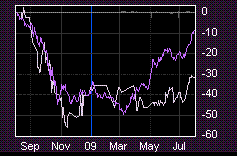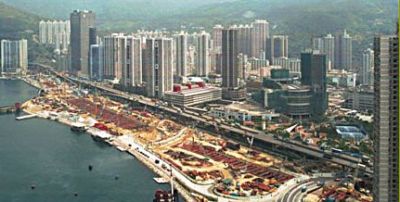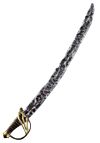SEBASTIAN CHONG looks unbeatable as he extended his gain from 51% to an enormous 83% just two months after this current round of Stock Challenge started.
The big booster in his portfolio is Yongnam warrant. He bet big on this and it has soared – an ultra-potent combination.
He had started off the Stock Challenge with the warrant constituting a whopping 35% of his hypothetical portfolio of $100,000. And now the stock has soared 142%! (Sebastian will be speaking on his stock picks at an Aug 15 seminar. For details, click here)

Another participant, neontet, is in No.2 position with a respectable 15% gain, thanks to Oceanus and Sinotel - two businesses that are on the cusp of experiencing unusually high growth. Incidentally, Sinotel figures also in the portfolios of Sebastian and 'Shuishui'.
Another stock, Techcomp Holdings, has caught the attention of two participants – neontet and Level 13. Techcomp has severely lagged behind the market. It started 2009 at 26 cents and it recently traded at .....28 cents.
Its upcoming half-year results will give clues as to whether the faith of the two participants will be richly rewarded.
Details of all four participants' portfolios and their commentaries are set out below. You are advised to do your own research and not to base your investment decisons on any comment made below:
| No. of shares | Purchase price ($) | July 31 closing | Value of holding ($) | |
Yanlord |
10,000 | 1.76 | 2.68 | 26,800 |
| Straits Asia | 15,000 | 1.16 | 2.13 | 31,950 |
| Straits Asia | 8,000 | 1.75 | 2.13 | 13,920 |
| Sinotel Technologies | 50,000 | 0.205 | 0.275 | 13,750 |
| Guthrie GTS | 30,000 | 0.28 | 0.335 | 10,050 |
| Yongnam wrt 121214 | 1 m | 0.035 | 0.085 | 85,000 |
| Cash | 1,570 | |||
| Total | 183,040 (+83%) |

Sebastian Chong has invested actively in equities since the 1970s. He is managing director of Financial Info Analysis Pte Ltd, a company he founded after he retired as an accounting professor at the National University of Singapore. He now runs his popular investing website, www.shareowl.com
Sebastian says:
On the last reporting date Friday 3 July, 2009, STI closed at 2,299.75. But just four weeks later on Friday July 31, 2009, the STI had soared further to 2,659.20 or up 15.6%. The portfolio value increased from $151,120 to $183.040 or 21.1%. The portfolio is hence up by 83% from its seed capital of $100,000 when this round of Stock Challenge began on May 18, 2009.
I decided to simply do nothing but continue to hold on to the same portfolio throughout the last four weeks. The operating and valuation fundamentals of all portfolio components still looked attractive to me under the principles of value investing and I decided to stick to the Warren Buffett principle of keeping one’s buy and sell transactions to a bare minimum most of the time. It is only when changes in economic, market and corporate fundamentals warrant it should we act boldly and resolutely after careful evaluation.
Yanlord continued to appreciate owing to the strong recovery of housing sales and prices in China cities. Besides it highly successful property launches in the last few months, its impressive but yet to be utilized land bank also ensures that there will be strong earnings in the years to come.
Straits Asia powered further as coal prices in the world markets outperformed those of crude oil and the price trend is likely to be upward in the coming months and years. Straits Asia was also helped by the high probability of increasing physical output for export from its Indonesian coal mines to the China and other markets. The re-election of Bambang Susilo Yudhoyono as President of Indonesia assured investors of continued political stability of Indonesia and the bombings in two Jarkarta hotels had virtually no adverse impact on the economic outlook and stability of Indonesia.

Sinotel continued its climb as China’s mobile telecommunications industry accelerated its adoption of 3G (third generation) networks. Sinotel has chalked up a record level of order books from its two main customers, China Unicom and China Mobile. I attended a presentation by Sinotel at the July 18-19 weekend Asian Investment Conference and Exhibition organized by SIAS. It was highlighted that several years ago there were over 300 players like Sinotel vying for projects from the mobile telcos in China but today only the strongest ones including Sinotel have survived and there are only around 50 players left.
With the very recent transition to 3G platform of mobile telecom networks in China, the size of the pie has increased exponentially and hence profit margins are unlikely to come down from the currently attractive levels for efficient players like Sinotel. Indeed the barriers for entry of new competitors are getting higher because of the need for high capital expenditure plus an accelerating rise in working capital since the giant telcos in China generally take six to nine months to pay application service providers like Sinotel.
Some analysts and investors are concerned over the long period of collection of receivables but since their customers are state controlled giant telcos, we just have to live with this inherent characteristic of the industry so long as the incidence of bad debts is close to zero. In return for the long collection period of receivables, Sinotel and its comparably efficient peers are compensated with the high profit margins (around 29% in 1H this year) that they can enjoy in this industry.
Guthrie GTS is of course solid as a rock as the bulk of its future revenues will come from its substantial stakes in Jurong Point and Tampines One plus other investment properties and hotels in Singapore, Indonesia and elsewhere in the region. All units in its 6-block Centris condominium were sold out by mid-2007 but since the profit on the condo is recognized progressively, the final batch of profit from the Centris would be recognized in 2009. Hence 2009 will see an impressive rise in bottom line profit over 2008 owing to this final profit recognition on the Centris plus the very steady income from the opening of the huge extension of lettable space in Jurong Point in December 2008 and the opening of brand new Tampines Mall in April 2009. Both heartland shopping malls are 100% tenanted.
Guthrie GTS is also currently engaged in being the consulting firm providing engineering and project management services for the current development of the Serangoon Central mega retail mall which will be 50% larger than Plaza Singapura in lettable space area. The mall should be completed within a couple of years. Guthrie has been a leader in construction engineering for many years and the Serangoon Central project is only one of the jobs that it in currently engaged in. I had highlighted Guthrie several months ago on Shareowl.com when the share price was 21 cents. It is currently 33.5 cents and its sustainable annual dividend is likely to be at least 2 cents a share these couple of years.

Yongnam warrant expiring in Dec 2012 is the brightest gem in the portfolio. The portfolio commenced on May 18 with an investment of $35,000 in the warrant but on July 31, this investment is worth $85,000. Short term (typically 6 months) covered warrants issued by investment banks on SGX listed companies should usually be traded actively because of their high volatility. But I intend to hold the Yongnam warrant till the end of this round of Stock Challenge in November 2009. As for my own real life holding of the warrants, it is possible that I might still be holding on to them throughout the whole of 2010 so long as the mother share remains strong in both operating and valuation fundamentals.
With more projects from the Singapore government and from overseas governments for steel struts and civil engineering services on infrastructure projects like mass transit railways, highways, flyovers and tunnels as well as large commercial and residential building projects, Yongnam’s outlook is bright in the next few years and probably throughout the next decade. Yongnam’s share price was a low 5 cents in October 2008 in the midst of panic selling of small cap stocks and the share price is now almost 6 times that October low. Yongnam is now a mid-cap stock with a market capitalization of over $350 million. From the 5 cent low in October 2008, the share price rocketed to a high of about 22 cents in early February 2009 but pulled back to only 8 cents in early March 2009 in another round of panic selling in the global stock markets. I seized the opportunity to buy more warrants at 2.5 cents. Indeed the lowest price I paid for the warrant was 1 cent in October 2008.
Even at Friday’s 8.5 cents, I would be foolhardy to take profit since the warrant expires only in December 2012 and the outlook for Yongnam looks very bright to me. Based on both the projected earnings growth plus the upward market rating of the Price/Earnings multiple, the mother share could conceivably hit $1.50 and the warrant could reach $1.20 before December 2012.
Yongnam could be a mother of all multi-baggers. I know that many institutions are not yet vested in Yongnam because its market capitalization of $350 million is far too small for big money or even medium money funds to look at it seriously. But this is a blessing for retail investors and for small boutique funds. When Yongnam’s market cap goes above $1 billion, even big money funds will just wake up and rush for it. My expectations are high but my risk appetite is only moderate.
I never put all my eggs in one basket and needless to say, my own investment in the Yongnam 2012 warrants is still small in my equities portfolio. And I keep stressing to the subscribers of Shareowl.com that any exposure to warrants should always be kept small. Indeed for the investor with a low risk appetite, a modest exposure to the Yongnam mother share would be good enough to yield a several fold return in the next few years.
No stock selection is fool-proof of course. Hence it is critical for me to monitor closely the fundamentals through public announcements and media news flow. This monitoring should be done for each portfolio component and its industry in my stock portfolio every day even though the initial intention is to treat it as a long term investment. A long term view is just not possible if one does not have the diligence to do daily monitoring. Investment based on fundamental analysis is hard work but it is also fun if you enjoy doing it and if you are decisive enough to know when to hold on, when to take profit and when to cut loss.
*****
| No. of units | Purchase price |
Sale price |
Jul 31 closing |
Value | |
Oceanus |
100,000 | 22 cents | 34 cents | $34,000 | |
| Oceanus | 50,000 | 31 cents | 34 cents | $17,000 | |
| Sinotel Technologies | 100,000 | 22.5 cents | 27.5 cents | $27,500 | |
| HSI MBL....PW091230 | 20,000 | 44 cents | 20.5 cents | ||
| Rickmers Maritime | 50,000 | 50.5 cents | 53.5 cents | ||
Techcomp |
110,000 | 28 cents | 28 cents | $30,800 | |
| Cash | $5,950 | ||||
Total |
$115,250 (+15.2%) |

Neontet is inclined towards high-growth small- and mid-cap stocks, preferring to stay away from most blue chips. He has had a good time investing in small- and mid-caps despite being burnt by some S-chips and Singapore companies with corrupt management.
He says:
Since the last report a month ago, my portfolio’s gain increased significantly from 5% to 15.2% because the core holdings – Oceanus and Sinotel – did very well.
The overall gain came about despite a sharp fall in one of the stocks, the put warrant on the Hang Seng Index, which I cut loss (53%) on subsequently. Warrants can be a real disaster in a portfolio!
I also sold Rickmers for a small profit after I understood better the financing challenges and industry doldrums that it faces. I have channelled all proceeds ($30,850) from the sale of Rickmers and the HSI warrant into Techcomp Holding, buying 110,000 shares at 28 cents a share.
I was alerted to the stock by the earlier purchase made by Level 13, another participant of this Stock Challenge. I was suitably impressed after reading Techcomp's press releases in recent months including the one where it said that it has been 'receiving inquries every day' on its laboratory equipment (for H1N1 testing & vaccine production, etc).
The business seems to be enjoying a strong business environment. In fact, Techcomp has announced that it enjoyed record sales in the first five months of this year.
Its stock price has not performed and trading in its stock has been lukewarm, but it could be an overlooked bargain. Since there are another 4 months to go for Stock Challenge, I think Techcomp stands a good chance of being re-rated if the half-year results to be announced soon prove to be as good as the press releases hint.
*****
| No. of shares | Average price bought at | Closing price on Jul 31 | Value | |
| Celestial | 296,998 | 18.49 cts | 17 cts | $50,489 |
| Sino Techfibre | 167,000 | 15 cts | 16.5 cts | $27,555 |
| Sinotel | 116,000 | 21.5 cts | 27.5 cts | $31,900 |
| Total | $109,944 (+9.9%) |

Shuishui, who is in his mid-30s, has been a stock investor for many years. A Singaporean, he has close ties with China as his parents and relatives are living there. He has taught himself how to analyse financial statements.
*****
| Stock | Number of shares | Average Purchase price ($) | July 31 closing price ($) |
Value of holding ($) |
| Techcomp | 200000 | 0.24 | 0.28 | 56,000 |
| STI 2200SGAePW091029 | 60000 | 0.245 | 0.085 | 5,100 |
| Cash | 43,450 | |||
| Total | 94,350 (-5.65%) |

Level 13 is a 31-year-old investor and a business analyst with 4 years of investing experience. Check out his blog for insights on financial matters (mainly equities).
Level 13 says:
The STI closed at 2659.2 last Friday for a gain of 15.6% in one month. During this month, I decided to cut loss on the Hong Kong put warrants (HSI17000BNPePW090828) at $0.165 apiece. On hindsight, that was the right decision. But I made a wrong decision to buy put warrants (STI2200SGAePW091029) on the STI. I am looking for an exit point and have 3 months to do it. Lastly, I added more Techcomp into my portfolio in anticipation of better financial results.
Generally speaking, risk aversion levels have risen across the board, regardless of countries. There are some areas which bubbles are forming again, just like the days in early 2007. In Singapore, we can see queues forming in the night, waiting to snap up units in property launches. In China, investors are tripping over themselves for a piece of the action in the world's second best performing stock market. Recently, about half a million new trading accounts are opened in China and the index went up to 3296, a level not seen since June 2008.
Currently, the price-to-book value of emerging-market stocks is now higher than those in the developed world. The only other time this valuation measure was at a premium to that of the developed world was from mid-2006 to mid-2007. Emerging-market equities fell by two-thirds in the 12 months to the start of November 2008. I am for the view that the market has gone ahead of its fundamentals. Although the medium-term outlook for markets in this region is appealing, the prospect of a slow and painful global economic recovery will translate into bouts of selling pressure.
Recent stories:
STOCK CHALLENGE: Sebastian resilient in market correction
SINOTEL TECHNOLOGIES: Beneficiary of 3G boom in China
TECHCOMP: "Record sales so far this year"
OCEANUS: Looking forward to better Q3, Q4
STRAITS ASIA RESOURCES, CHINA XLX, INDOAGRI: What analysts say







